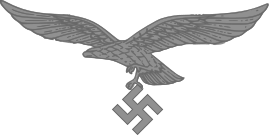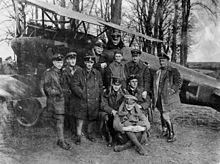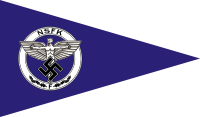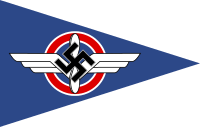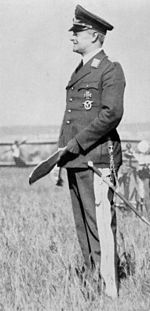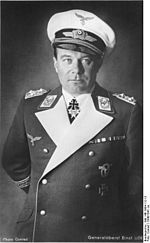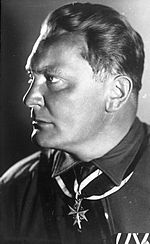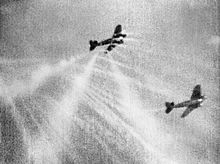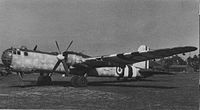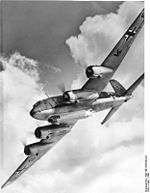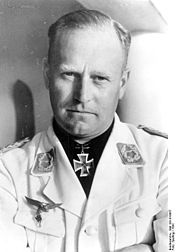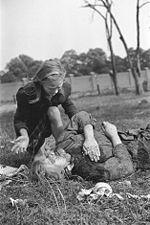
Luftwaffe
Background Information
This Wikipedia selection is available offline from SOS Children for distribution in the developing world. A good way to help other children is by sponsoring a child
| Luftwaffe | |
|---|---|
|
Luftwaffe eagle |
|
| Active | 1935–1945 |
| Country | Nazi Germany |
| Type | Air Force |
| Part of | Wehrmacht |
| Engagements | World War II |
| Commanders | |
| Notable commanders |
Hermann Göring |
| Insignia | |
| Luftwaffe eagle. The image is attached to a Luftflotte | 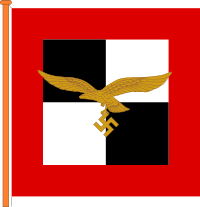 |
| Narrow-flank Balkenkreuz used on upper wing surfaces | 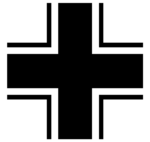 |
| Wide-pattern Balkenkreuz for wing undersurfaces and fuselage sides |  |
The Luftwaffe was the aerial warfare branch of the German Wehrmacht during World War II. After the German Empire's World War I-era army air force, the Luftstreitkräfte, and the Kaiserliche Marine naval air units had been disbanded under the terms of the Treaty of Versailles, the Luftwaffe was reformed on February 26, 1935 and grew to become one of the strongest, most doctrinally advanced, and most battle-experienced air forces in the world when World War II started in Europe in September 1939. After the defeat of the Third Reich, the Luftwaffe was disbanded in 1946.
Luftwaffe is also the generic term in German speaking countries for any national military aviation service, and the names of air forces in other countries are usually translated into German as "Luftwaffe" (e.g. Royal Air Force is often translated as "britische Luftwaffe"). However, Luftstreitkräfte, or "air armed force", is also sometimes used as a translation of "air force". And because "Luft" means "air" and "Waffe" may be translated into English as either "weapon" or "arm", "Air Arm" may be considered the most literal English translation of Luftwaffe (cf. Fleet Air Arm).
Origin of Luftwaffe
World War I
One of the forerunners of the Luftwaffe, the Imperial German Army Air Service, was founded in 1910 with the name Die Fliegertruppen des deutschen Kaiserreiches. It was renamed Luftstreitkräfte by October 1916. The air war on the Western Front received the most attention in the annals of military aviation, since it produced aces such as Manfred von Richthofen, popularly known as the Red Baron, Ernst Udet, Hermann Göring, Oswald Boelcke, Werner Voss, and Max Immelmann, many of whom would later serve in the Luftwaffe.
After the defeat of Germany, the service was dissolved on 8 May 1920 under the conditions of the Treaty of Versailles, which also mandated the destruction of all military aircraft of Germany.
Interwar period
Since the Treaty of Versailles forbade Germany to have an air force, German pilots trained in violation of the treaty in secret. Initially, civil aviation schools within Germany were used, yet only light trainers could be used in order to maintain the façade that the trainees were going to fly with civil airlines such as Deutsche Luft Hansa. To train its pilots on the latest combat aircraft, Germany solicited the help of its future enemy, the Soviet Union, which was also isolated in Europe. A secret training airfield was established at Lipetsk in 1924 and operated for approximately nine years using mostly Dutch and Russian, but also some German, training aircraft before being closed in 1933. This base was officially known as 4th squadron of the 40th wing of the Red Army.
The first steps towards the Luftwaffe's formation were undertaken just months after Adolf Hitler came to power. Hermann Göring, a World War I ace with 22 victories and the holder of the Orden Pour le Merite, became National Kommissar for aviation with former Deutsche Luft Hansa director Erhard Milch as his deputy. In April 1933 the Reichsluftfahrtministerium (RLM – Reich Air Ministry) was established. The RLM was in charge of development and production of aircraft, and soon afterwards the test site or Erprobungsstelle at Rechlin became its testing ground, a military airfield that had been first established in August 1918. Göring's control over all aspects of aviation became absolute. On 25 March 1933 the Deutschen Luftsportverband (DVLA) (German Air Sport Association) absorbed all private and national organizations, whilst retaining its 'sports' title. The merging of all military aviation organizations in the RLM took place on 15 May 1933, which became the Luftwaffe's official 'birthday'. Many members of the Nationalsozialistisches Fliegerkorps (National Socialist Flyers Corps – NSFK) transferred to the Luftwaffe. As all such prior NSFK members were also Nazi Party members, this gave the new Luftwaffe a strong Nazi ideological base in contrast to the other branches of the German military. Göring had played a leading role in the build up of the Luftwaffe in 1933–1936, but played little further part in the development of the Luftwaffe until 1936, and Milch became the "de facto" minister until 1937.
The absence of Göring in planning and production matters was fortunate. Göring had little knowledge of current aviation, had last flown in 1922, and had not kept himself informed of latest events. Göring also displayed a lack of understanding of doctrine and technical issues in aerial warfare which he left to others more competent. The Commander-in-Chief left the organisation and building of the Luftwaffe, after 1936, to Erhard Milch. However Göring, as a part of Hitler's inner circle, was to provide enormous financial materials for rearming and equipping the Luftwaffe.
Another prominent figure in German air power construction this time was Helmuth Wilberg. Wilberg was to play a large role in the development of German air doctrine. Having headed the Reichswehr air staff for eight years in the 1920s, Wilberg had considerable experience and was ideal for a senior staff position. Göring considered making Wilberg Chief of Staff (CS). However, it was revealed Wilberg had a Jewish mother. For that reason Göring could not have him as CS. Not wishing his talent to go to waste, Göring ensured the racial laws of the Third Reich did not apply to him. Wilberg remained in the air staff and helped draw up the principle doctrine "The Conduct of the Aerial War" and its "Regulation 16" under Walther Wever.
Preparing for war: 1933–1939
The Wever years, 1933 – 1936
Contrary to popular belief in American and British circles, the Luftwaffe was not "the hand maiden of the German Army." The German officer Corps was keen to develop strategic bombing capabilities against its enemies. However, economic and geopolitical considerations had to take priority. The German air power theorists continued to develop strategic theories, but emphasis was given to army support, as Germany was a continental power and expected to face ground operations following any declaration of hostilities.
For these reasons, between 1933 and 1934, the Luftwaffe's leadership was primarily concerned with tactical and operational methods. In aerial terms, the army concept of Truppenführung was an operational concept, as well as a tactical doctrine. In the First World War, air units had been attached to specific army formations and acted as support. Dive bomber units were considered essential to Truppenführung; destroying Headquarters and lines of communications. Luftwaffe "Regulation 10: The Bomber" (Dienstvorschrift 10: Das Kampfflugzeug), published in 1934, advocated air superiority and approaches to ground attack tactics without dealing with operational matters. Until 1935, the 1926 manual "Directives for the Conduct of the Operational Air War" continued to act as the main guide for German air operations. The manual directed the OKL to focus on limited operations (not strategic-operations); the protection of specific areas and support of the army in combat.
With an effective tactical-operational concept, the German air power theorists needed a strategic doctrine and organisation. Robert Knauss, a serviceman (not pilot) in the Luftstreitkräfte during the First World War, and later an experienced pilot with Lufthansa, was a prominent theorist of air power. Knauss promoted the Giulio Douhet theory that air power could win wars alone by destroying enemy industry and morale by "terrorizing the population" of major cities. This advocated attacks on civilians. The General Staff blocked the entry of Douhet's theory into doctrine, fearing revenge strikes against German civilians and cities.
In December 1934, Chief of the Luftwaffe General Staff Walther Wever sought to mould the Luftwaffe's battle doctrine into a strategic plan. At this time, Wever conducted war games (simulated against the French) in a bid to establish his theory of a strategic bombing force that would, he thought, prove decisive by winning the war through the destruction of enemy industry, even though these exercises also included tactical strikes against enemy ground forces and communications. In 1935, "Luftwaffe Regulation 16: The Conduct of the Air War" was drawn up. In the proposal, it concluded, "The mission of the Luftwaffe is to serve these goals."
Within this doctrine, the Luftwaffe leadership rejected the practice of " terror bombing" (see Luftwaffe strategic bombing doctrine). Terror bombing was deemed to be "counter-productive", increasing rather than destroying the enemy's will to resist. Such bombing campaigns were regarded as diversion from the Luftwaffe's main operations; destruction of the enemy armed forces. The bombings of Guernica, Rotterdam and Warsaw were considered tactical missions in support of military operations and were not intended as strategic terror attacks.
Nevertheless, Wever recognised the importance of strategic bombing. In newly introduced doctrine, The Conduct of the Aerial Air War in 1935, Wever rejected the theory of Douhet and outlined five key points to air strategy:
1. To destroy the enemy air force by bombing its bases and aircraft factories, and defeating enemy air forces attacking German targets.
2. To prevent the movement of large enemy ground forces to the decisive areas by destroying railways and roads, particularly bridges and tunnels, which are indispensable for the movement and supply of forces
3. To support the operations of the army formations, independent of railways, i.e, armoured forces and motorised forces, by impeding the enemy advance and participating directly in ground operations.
4. To support naval operations by attacking naval bases, protecting Germany's naval bases and participating directly in naval battles
5. To paralyse the enemy armed forces by stopping production in the armaments factories.
Wever began planning for a strategic bomber force and sought to incorporate strategic bombing into a war strategy. He believed that tactical aircraft should only be used as a step to developing a strategic air force. In May 1934, Wever initiated a seven-year project for the "Ural Bomber", the bomber that would take the Luftwaffe's bombing campaign into the heart of the Soviet Union. In 1935, this led to the Dornier Do 19 and Junkers Ju 89 prototypes, although both were underpowered. In April 1936, Wever ordered a requirement for 'Bomber A' which would have a range of 6,700 km (4,163 mi) with a 900 kg (1,984 lb) bomb load. However Wever's vision of a "Ural" bomber was never realised, and his emphasis on strategic aerial operations was lost, with the only design submittal for Wever's 'Bomber A' that would reach production being Heinkel's Projekt 1041, which became officially known on 5 November 1937 as the Heinkel He 177.
By the late 1930s the Luftwaffe had no clear purpose. The air force was not subordinated to the army support role, and it was not given any particular strategic mission. German doctrine fell between the two concepts. The Luftwaffe was to be an organisation capable of carrying out broad and general support tasks rather than any specific mission. Mainly, this path was chosen to encourage a more flexible use of air power and offer the ground forces the right conditions for a decisive victory. In fact, on the outbreak of war, only 15% of the Luftwaffe's aircraft was devoted to ground support operations, exposing a long-held myth that the Luftwaffe was designed for only tactical and operational missions.
A change of direction, 1936 – 1937
Wever's participation in the construction of the Luftwaffe came to an abrupt end on 3 June 1936 when he was killed along with his engineer in a Heinkel He 70 Blitz, ironically on the very day that his "Bomber A" heavy bomber design competition was announced. After Wever's death Göring began taking more of an interest in the appointment of Luftwaffe staff officers. Göring appointed his successor Albert Kesselring as CS and Ernst Udet head the Reich's Air Ministry Technical Office (Technisches Amt), although he was not a technical expert. Despite this Udet was appointed to and helped change the Luftwaffe's tactical direction towards producing fast medium bombers that were to destroy enemy air power in the battle zone rather than through industrial bombing of its aviation production.
Kesselring and Udet did not get on. During Kesselring's time as CS, 1936–1937, a power struggle developed between the two as Udet attempted to extend his own power within the Luftwaffe. Kesselring also had to contend with Göring appointing "yes men" to positions of importance. Udet realised his limitations, and his failures in the production and development of German aircraft would have serious long term consequences.
The failure of the Luftwaffe to progress further towards attaining a strategic bombing force was attributable to several reasons. Many in the Luftwaffe command believed medium bombers to be sufficient power to launch strategic bombing operations against Germany's most likely enemies; France, Czechoslovakia and Poland. The United Kingdom presented greater problems. General der Flieger Hellmuth Felmy, commander of Luftflotte 2 in 1939, was charged with devising a plan for an air war over the British Isles. Felmy was convinced that Britain could be defeated through morale bombing. Felmy noted the alleged panic that had broken out in London during the Munich crisis, evidence he believed of British weakness. A second reason was technical. German designers had never solved the issues of the Heinkel He 177 design difficulties, brought on by the requirement from its inception on November 5, 1937 to have moderate dive bombing capabilities in a 30 meter wingspan class military aircraft. Moreover, Germany did not possess the economic strength and resources to match the later British and American effort of 1943–1944, particularly in large-scale mass production of high power output aircraft powerplants, those capable of a maximum output of at least 1,500 kW (2,000 hp) apiece. In addition, the OKL had not foreseen the industrial and military effort strategic bombing would require. By 1939 the Luftwaffe was not much better prepared than its enemies to conduct a strategic bombing campaign, with fatal results during the Battle of Britain.
The German rearmament program faced difficulties acquiring raw materials. Germany imported most of its essential materials for rebuilding the Luftwaffe, in particular rubber and aluminium. Petroleum imports were particularly vulnerable to blockade. The Germans pushed for synthetic fuel plants, but still failed to meet demands. In 1937 Germany imported more fuel than it had at the start of the decade. By the summer 1938 only 25% of requirements could be covered. In steel materials, industry was operating at barely 83% and by November 1938 Göring reported the economic situation was serious. The Oberkommando der Wehrmacht (OKW), the overall command for all German military forces, ordered reductions in raw and steel materials for armament production. The figures for reduction were substantial: 30% steel, 20% copper, 47% aluminium and 14% rubber. Under such circumstances, it was not possible for Milch, Udet or Kesselring to produce a formidable strategic bombing force even had they wanted to do so.
The development of aircraft was now confined to the production of twin-engined medium bombers that required much less material, manpower and aviation production capacity than Wever's 'Ural Bombers'. German industry could build two medium bombers for one heavy bomber and the RLM would not gamble on developing a heavy bomber which would also take time. Göring remarked, "the Führer will not ask how big the bombers there are, but only how many there are". The premature death of one of the Luftwaffe's finest officers, one that left the Luftwaffe without a strategic air force during World War II, eventually proved fatal to the German war effort.
The lack of strategic capability should have been apparent much earlier. The Sudeten Crisis highlighted German unprepardness to conduct a strategic air war (although the British and French were in a much weaker position), and Hitler ordered the Luftwaffe be expanded by five times. The OKL badly neglected the need for transport aircraft; even in 1943, transport units were described as Kampfgeschwadern zur besonderen Verwendung ("Bomber Units on Special Duties", KGzbV). and only grouping them together into dedicated cargo and personnel transport wings (Transportgeschwader) during that year. In March 1938, as the Anschluss was taking place, Göring ordered Felmy to investigate the prospect of air raids against Britain. Felmy concluded it was not possible until bases in Belgium and the Netherlands were obtained and the Luftwaffe had heavy bombers. Fortunately it mattered little, as the British betrayed the Czechs, war was avoided, and the need for long-range aircraft did not arise.
These failures were not exposed until wartime. In the meantime German designs of mid-1930s origin such as the Messerschmitt Bf 109, Heinkel He 111, Junkers Ju 87 Stuka, and Dornier Do 17, performed very well. All first saw active service in the Condor Legion against Soviet-supplied aircraft. The Luftwaffe also quickly realized the days of the biplane fighter were finished, the Heinkel He 51 being switched to service as a trainer. Particularly impressive were the Heinkel and Dornier, which fulfilled the Luftwaffe's requirements for bombers that were faster than fighters.
Despite the participation of these aircraft (mainly from 1938 onward), it was the venerable Junkers Ju 52 (which soon became the backbone of the Transportgruppen) that made the main contribution. During the Spanish Civil War Hitler remarked, "Franco ought to erect a monument to the glory of the Junkers Ju 52. It is the aircraft which the Spanish revolution has to thank for its victory".
Dive-bombing
Poor accuracy from level bombers in 1937 led the Luftwaffe to grasp the benefits of dive-bombing. The latter could achieve far better accuracy against small mobile tactical targets than heavier, conventional bombers. Range was not key criteria for these tasks and it was not always viable for the Army to move heavy artillery over recently captured territory to bombard fortifications or support ground forces when faster dive-bombers could do the job more quickly. Dive-bombers, often single-engine two-man machines, could achieve better results than larger six or seven-man aircraft, at a tenth of the cost and four times the accuracy. This led to Ernst Udet championing the dive-bomber, particularly the Junkers Ju 87.
Udet's "love affair" with dive-bombing seriously affected the long-term development of the Luftwaffe, especially after General Wever's untimely death. The tactical strike aircraft programs were meant to serve as interim solutions until the next generation of aircraft arrived. In 1936 the Junkers Ju 52 was the backbone of the German bomber fleet. This led to a rush on the part of the RLM to produce the Junkers Ju 86, Heinkel He 111 and Dornier Do 17 before a proper evalutation was made. The Ju 86 was poor while the He 111 showed most promise. The Spanish Civil War convinced Udet (along with limited output from the German munitions industry) that wastage was not acceptable in munition terms. Udet sought to build dive-bombing into the Junkers Ju 88 and conveyed the same idea, initiated specifically by the OKL, for the Heinkel He 177, approved in early November 1937. In the case of the Ju 88, 50,000 modifications had to be made. The weight was increased from seven to twelve tons. This resulted in a speed loss of 200 km/h. Udet merely conveyed the OKL's own dive-bombing capability request to Ernst Heinkel concerning the He 177, who vehemently opposed such an idea, which ruined its development as a heavy bomber. Göring did not rescind the dive bombing requirement for the He 177A until September 1942.
Mobilisation, 1938 – 1939
By the summer of 1939, the Luftwaffe had nine Jagdgeschwader (fighter wings) mostly equipped with Messerschmitt Bf 109, four ' Zerstörergeschwader (destroyer wings) equipped with the Messerschmitt Bf 110 heavy fighter, 11 Kampfgeschwader (bomber wings) equipped with mainly the Heinkel He 111 and the Dornier Do 17Z, and four Sturzkampfgeschwader (dive bomber wings). The Junkers Ju 88 had encountered design difficulties, as a result only 12 were available when hostilities commenced. The Luftwaffe's strength at this time stood at 373,000 personnel (208,000 parachute troops, 107,000 in the Flak Corps and 58,000 in the Signals Corps). Aircraft strength was 4,201 operational aircraft; 1,191 bombers, 361 dive bombers, 788 fighters, 431 heavy fighters, and 488 transports. Despite deficiencies it was an impressive force.
However, even by the spring of 1940, the Luftwaffe still had not mobilized fully. Despite the shortage of raw-materials Generalluftzeugmesiter Ernst Udet, had increased production through introducing a 10 hour working day for aviation industries and rationalizing of production. During this period 30 Kampfstaffeln and 16 Jagdstaffeln were being raised and equipped. A further five Zerstorergruppen were created (JGr 101, 102,126,152 and 176), all equipped with the Bf 110.
The Luftwaffe also greatly expanded its aircrew training programs by 42%, to 63 flying schools. These facilities were moved to eastern Germany, away from possible Allied threats. The number of aircrew reached 4,727, an increase of 31%. However, the rush to complete this rapid expansion scheme resulted in the deaths of 997 personnel and another 700 wounded. 946 aircraft were also destroyed in these accidents. The number of aircrew completing their training was up to 3,941, The Luftwaffe's entire strength was now 2.2 million personnel.
Luftwaffe organization
Luftwaffe commanders
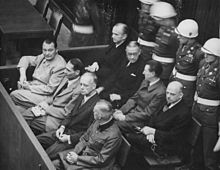
Throughout the history of the Third Reich, the Luftwaffe had only two commanders-in-chief. The first was Hermann Göring, with the second and last being Generaloberst Robert Ritter von Greim. His appointment as commander-in-chief of the Luftwaffe was concomitant with his promotion to Generalfeldmarschall, the last German officer in World War II to be promoted to the highest rank. Other officers promoted to the second highest military rank in Germany were Albert Kesselring, Hugo Sperrle, Erhard Milch, and Wolfram von Richthofen.
At the end of the war, with Berlin surrounded by the Red Army, Göring sent a telegram to Hitler suggesting he take over leadership of the Reich. Hitler interpreted this as an ultimatum and coup. Hitler ordered his arrest and execution. Göring's SS guards did not carry out the order and he was arrested by the United States Army in Bavaria on 9 May 1945. Göring was prosecuted at the Nuremberg Trials after the war. The indictments were for:
- Participation in a common plan or conspiracy for the accomplishment of a crime against peace
- Planning, initiating and waging wars of aggression and other crimes against peace
- War crimes
- Crimes against humanity
He was found guilty on all four counts and sentenced to death by hanging. He appealed to the court requesting to be shot as a soldier. The court refused. However, Göring defied the sentence and committed suicide by taking potassium cyanide.
Sperrle was prosecuted at the OKW Trial, one of the last twelve of the Nuremberg Trials after the war. He was acquitted on all four counts of all charges. He died in Munich in 1953.
Organization and chain of command
At the start of the war the Luftwaffe had four Luftflotten ("air fleets"), each responsible for roughly a quarter of Germany. As the war progressed more air fleets were created as the areas under German rule expanded. As one example, Luftflotte 5 was created in 1940 to direct operations in Norway and Denmark, and other Luftflotten were created as necessary. Each Luftflotte would contain several Fliegerkorps (Air Corps), Fliegerdivision (Air Division), Jagdkorps (Fighter Corps), Jagddivision (Air Division) or Jagdfliegerführer (Fighter Air Command). Each formations would have attached to it a number of units, usually several Geschwader, but also independent Staffeln and Kampfgruppen. Luftflotten were also responsible for the training aircraft and schools in their operational areas.
A Geschwader was commanded by a Geschwaderkommodore, with the rank of either major, Oberstleutnant ( lieutenant colonel) or Oberst ( colonel). Other "staff" officers within the unit with administrative duties included the adjutant, technical officer, and operations officer, who were usually (though not always) experienced aircrew or pilots still flying on operations. Other specialist staff were navigation, signals and intelligence personnel. A Stabschwarm ( headquarters flight) was attached to each Geschwader.
Jagdgeschwader (Fighter wings) (JG) were single-seat day fighter Geschwaders (literally "hunting wings"), typically equipped with Bf 109 or Fw 190 aircraft flying in the fighter or fighter-bomber roles. It consisted of groups (Gruppen), which in turn consisted of Jagdstaffel (fighter squadrons). Hence, Fighter Wing 1 was JG 1, its first Gruppe (group) was I./JG 1, using a Roman numeral for the Gruppe number only, and its first Staffel (squadron) was 1./JG 1. Geschwader strength was usually 120 – 125 aircraft.
Each Gruppe was commanded by a Kommandeur, and a Staffel by a Staffelkapitãn. However, these were "appointments", not ranks, within the Luftwaffe. Usually, the Kommodore would hold the rank of Oberstleutnant (lieutenant colonel) or, exceptionally, an Oberst (colonel). Even a Leutnant (second lieutenant) could find himself commanding a Staffel.
Similarly, a bomber wing was a Kampfgeschwader (KG), a night fighter wing was a Nachtjagdgeschwader (NJG), a dive-bomber wing was a Stukageschwader (StG), and units equivalent to those in RAF Coastal Command, with specific responsibilities for coastal patrols and search and rescue duties, were Küstenfliegergruppen (Kü.Fl. Gr.). Specialist bomber groups were known as Kampfgruppen (KGr). The strength of Geschwader was about 80 – 90 aircraft.
Spanish Civil War
The Luftwaffe's Condor Legion experimented with new doctrine and aircraft during the Spanish Civil War. It helped the Falange under Francisco Franco to defeat the Republican forces. Over 20,000 German airmen gained combat experience that would give the Luftwaffe an important advantage going into the Second World War. One infamous operation was the bombing of Guernica in the Basque country. It is commonly assumed this attack was the result of a "terror doctrine" in Luftwaffe doctrine. The Luftwaffe did not apparently have an official policy of terror bombing in which civilians were deliberately targeted, but the effects of the raids on Guernica and Madrid caused many civilian casualties and a wave of protests in the democracies. It has been suggested that the bombing of Guernica was carried out for military tactical reasons, in support of ground operations, but the town was not directly involved in any fighting at that point in time. It was not until 1942 that the Germans started to develop bombing policy in which civilians were the primary target, although The Blitz on London and many other British cities involved indiscriminate bombing of civilian areas.
Second World War
When the Second World War began, the Luftwaffe was one of the most technologically advanced air forces in the world. During the Polish Campaign that triggered the war, it established air superiority, and then air supremacy, quickly. It supported German Army (Heer) operations which ended the campaign in five weeks. The Luftwaffe's performance was as the Oberkommando der Luftwaffe had hoped. The Luftwaffe had rendered invaluable support to the army, mopping up pockets of resistance. Göring was delighted with the performance. Command and control problems were experienced, but owing to the flexibility and improvisation of both the army and Luftwaffe, these problems were solved. The Luftwaffe was to have in place a ground-to-air communication system, which played a vital role in the success of Fall Gelb.
In the spring of 1940, the Luftwaffe assisted the Kriegsmarine and Heer in the daring invasion of Norway, Operation Weserübung. Flying in reinforcements and winning air superiority, the Luftwaffe contributed decisively to the German conquest and expulsion of the Western Allies from Scandinavia.
In the summer of 1940, the Luftwaffe contributed to the unexpected success in the Battle of France. It helped destroy three Allied Air Forces and secure the defeat of France in just over six weeks. However, during the Battle of Dunkirk despite intense bombing, it could not deliver Göring's promise to destroy the British Expeditionary Force, which escaped to continue the war.
During the Battle of Britain, the Luftwaffe, despite causing severe damage to the Royal Air Force's infrastructure and British cities during the subsequent Blitz, did not achieve the air superiority that Hitler demanded for Operation Sea Lion as the invasion was cancelled in December 1940, when Hitler ordered preparations to be made for Operation Barbarossa, the invasion of the Soviet Union. The following spring, the Luftwaffe helped its Axis partner, Italy secure victory in the Balkans Campaign and continued to support the Italians in the Mediterranean, Middle East and African theatres until May 1945.
In June 1941, Germany invaded the Soviet Union. The Luftwaffe destroyed thousands of Soviet aircraft. But it failed to destroy the Red Air Force. Due to a lack of Strategic bombers - the very "Ural bombers" that General Wever had asked for six years before - the Luftwaffe could not strike at Soviet production centers regularly or with the needed force. As the war dragged on, the Luftwaffe was eroded in strength. The defeats at the Battle of Stalingrad and Battle of Kursk ensured the gradual decline of the Wehrmacht on the Eastern Front.
Meanwhile, the Luftwaffe continued to defend German–occupied Europe against the growing offensive power of RAF Bomber Command and the United States Army Air Forces. The Defence of the Reich campaign gradually destroyed the Luftwaffe's fighter arm. Despite its belated use of advanced turbojet and rocket propelled aircraft for bomber destroyer duties, it was overwhelmed by Allied numbers and a lack of trained pilots and fuel. A last-ditch attempt, known as Operation Bodenplatte, to win air superiority on 1 January 1945 failed. After the Bodenplatte effort, the Luftwaffe had ceased to be an effective fighting force.
Omissions and failures
Mistakes in Command: The lack of aerial defence
The failure of the Luftwaffe in the Defence of the Reich campaign was a result of a number of factors. The Luftwaffe lacked an effective air defence system early in the war. Adolf Hitler's foreign policy had pushed Germany into war before these defences could be fully developed. The Luftwaffe was forced to improvise and construct its defences during the war. The daylight actions over German controlled territory were sparse in 1939–1940. The responsibility of the defence of German air space fell to the Luftgaukommandos (air district commands). The defence systems relied mostly on the Flak arm. The defences were not coordinated and communication was poor. This lack of understanding between the Flak and flying branches of the defence would plague the Luftwaffe throughout the war. Hitler in particular wanted the defence to rest on anti-aircraft artillery as it gave the civilian population a "psychological crutch" no matter how ineffective the weapons.
Most of the battles fought by the Luftwaffe on the Western Front would be against the RAF's "Circus" raids and the occasional daylight raid into German air space. This was a fortunate position since the Luftwaffe's strategy of focusing its striking power on one front started to unravel with the failure of Operation Barbarossa, the invasion of the Soviet Union. The "peripheral" strategy of the Luftwaffe between 1939–1940 had been to deploy its fighter defences at the edges of Axis occupied territory, with little protecting the inner depths. Moreover the front line units in the West were complaining about the poor numbers and performance of aircraft. Units complained of lack of Zerstörer aircraft with all-weather capabilities and the "lack of climbing power of the Bf 109". The Luftwaffe's technical edge was slipping as the only formidable new aircraft in the German arsenal was the Focke-Wulf Fw 190. Generalfeldmarschall Erhard Milch was to assist Ernst Udet with aircraft production increases and introduction of more modern types of fighter aircraft. However, they explained at a meeting of the Reich Industrial Council on 18 September 1941 that the new next generation aircraft had failed to materialise, and obsolescent types had to be continued to keep up with the growing need for replacements.
The build up of the Jagdwaffe (Fighter Force) was too rapid and its quality suffered. It was not put under a unified command until 1943, which also affected performance. Of the nine Jagdgeschwader in existence in 1939, no further units were built until 1942, and the years of 1940–1941 were wasted. The Oberkommando der Luftwaffe failed to construct a strategy, instead its command style was reactionary, and its measures not as effective without thorough planning. This was particularly apparent with the Fw 190A-equipped Sturmbock units which were armed with heavy 20 mm and 30 mm cannon to destroy heavy bombers. This increase in weight affected the performance of the Fw 190 and Bf 109 at a time when the two aircraft were meeting large numbers of equal if not superior Allied types.
Mistakes in development and equipment
A significant failure in terms of technological development was not to develop a long-range bomber and capable long-range fighters during this period leaving the Luftwaffe unable to conduct a meaningful strategic bombing campaign throughout the war. However, this does not take into the account that Germany's economic situation suffered from limited resources – mainly raw materials like oil and aluminium – which did not provide for much beyond a tactical air force. Thus, the Luftwaffe's reliance on tactical mid-range, twin engined medium bombers and short range dive-bombers was a rational option under these circumstances. It might also be argued that the Luftwaffe's Kampfgeschwader medium and heavy bomber wings were perfectly capable of attacking strategic targets, but the lack of a capable long range escort fighter left the bombers unable to carry out their missions effectively against determined and well organised fighter opposition. The largest failure for the Kampfgeschwader, however, was saddling them with an aircraft meant to be as big and as apparently capable as any Allied four-engined "heavy bomber" – the perpetually troubled Heinkel He 177 – which had been condemned to being designed to carry out moderate angle dive bombing missions from the day that the RLM accepted it for production in November 1937, making it overweight from the start, and mandating design features that led its "welded-together engines", a pair of cumbersome Daimler-Benz DB 606 "power systems", to perpetually catching fire in flight during operational missions over both the Eastern Front and the United Kingdom. It was not until the concluding months of 1943 that the only realized attempt out of a trio of parallel proposals from the Heinkel engineering departments to build a "true four engined" version of the A-series He 177, the He 177B emerged with only three airworthy prototypes produced by early 1944, some three years after the first flights of the Avro Lancaster prototypes, the most commonly encountered RAF bomber pounding Germany on strategic night raids from 1942 to the end of the war in Europe.
Another failure of procurement and equipment was a lack of a dedicated naval air arm. General Felmy had already expressed a desire to build a naval air arm to support Kriegsmarine operations in the Atlantic and British waters. Britain was dependent on food and raw materials from its Empire and North America. Felmy pressed this case firmly throughout 1938 and 1939, and, on 31 October 1939, Großadmiral Erich Raeder sent a strongly worded letter to Goering in support of such proposals. The current twin-engined Heinkel He 115 floatplane and Dornier Do 18 flying boat were too slow and short-ranged. The Dornier Do 217 would have been ideal, but suffered production problems. Raeder also complained about the poor standard of aerial torpedoes, although their design was the Kriegsmarine's responsibility. (See: Heinkel He 111 torpedo bomber operations) Without specialised naval or maritime patrol aircraft, the Luftwaffe was forced to improvise. The Focke-Wulf Fw 200 Condor airliner's airframe made it unsuitable as a bomber, lacking speed, armour and bomb load capacity. Nevertheless this civilian transport was adapted to the long-range reconnaissance and anti-shipping roles and, between August 1940 and February 1941, Fw 200s sank 85 vessels for a claimed total of 363,000 Grt. Had the Luftwaffe focused on naval aviation - particularly maritime patrol aircraft with long range - Germany might well have been in a position to win the Battle of the Atlantic. However, Raeder and the Navy failed to press for naval air power until the war began, mitigating the Luftwaffe's responsibility. In addition, Goering regarded any other branch of the German military developing its own aviation as an encroachment on his authority and continually frustrated the navy's attempts to build its own airpower.
The absence of a strategic bomber force for the Luftwaffe, following General Wever's accidental death in 1936 and the end of the Ural bomber program he fostered before the invasion of Poland, would not be addressed again until the authorization of the Bomber B design competition in July 1939, which sought to replace the medium bomber force with which the Luftwaffe was to begin the war, with more advanced, twin-engined high speed bomber aircraft fitted with pairs of relatively "high-power" engines of 1,500 kW (2,000 hp) output levels and upwards each, that would also be able to function as shorter range heavy bombers.
The spring 1942 Amerika Bomber program also sought to produce useful strategic bomber designs for the Luftwaffe, with their prime design priority being an advanced trans-oceanic range capability as the main aim of the project to directly attack the United States from Europe or the Azores. Inevitably, both the Bomber B and Amerika Bomber programs were victims of the continued emphasis of the Wehrmacht's insistence for the Luftwaffe to support the Army as its primary mission, as well as the increasingly devastating results of the RAF Bomber Command at night, and by 1943 the USAAF's Eighth and Fifteenth Air Forces' heavy bomber raids by daylight on the German aviation industry, which catastrophically diminished the Third Reich's overall aviation production capacity later in World War II.
The RLM lacked a "technical-tactical" department, that would have been able to combine the two functions for better efficiency. The Luftwaffe did have its own reasonably effective system of four military aviation test facilities, or Erprobungstellen located at three coastal sites - Peenemünde-West (also incorporating a separate facility in nearby Karlshagen), Tarnewitz and Travemünde - and the central inland site of Rechlin, itself first established as a military airfield in late August 1918 by the German Empire, with the four-facility system commanded later in World War II by Oberst (Colonel) Edgar Petersen. As a result of the lack of co-ordination between the RLM ministry and the OKL, all fighter and bomber development was oriented toward short range aircraft, as they could be produced in greater numbers, rather than quality long range aircraft, something that put the Luftwaffe at a disadvantage as early as the Battle of Britain. Production was also slow, not reaching maximum output until 1944. Production of fighters was not given priority until 1944; Adolf Galland commented that this should have occurred at least a year earlier. Galland also points to the mistakes and challenges made in the development of the Me 262 jet - which included the protracted development time required for its Junkers Jumo 004 jet engines to improve their reliability - meaning that the Me 262A fighter variants could have entered service in 1943 had such challenges been overcome, when the outcome of the air-war was still in doubt. Types that were obsolete were kept in production for far too long, in particular the Ju 87 Stuka, and the Bf 109.
Production failures
The failure of German production was evident from the start of the Battle of Britain. By the end of 1940 the Luftwaffe had suffered heavy losses and needed to regroup. Deliveries of new aircraft were insufficient to meet the drain on resources; the Luftwaffe, unlike the RAF, was failing to expand its pilot and aircraft numbers. This was partly owing to production planning failures before the war and the demands of the army. Nevertheless, the German aircraft industry was being outproduced in 1940. In terms of fighter aircraft production, the British exceeded their production plans by 43%, while the Germans remained 40% "behind" target by the summer 1940. In fact German production in fighters fell from 227 to 177 per month between July and September 1940. One of the many reasons for the failure of the Luftwaffe in 1940 was that it did not have the operational and material means to destroy the British aircraft industry.
No effort was made to address the low production output of the German aviation industry to support the expected increased attrition rates. The so-called "Göring program" envisaged the defeat of the Soviet Union in 1941. Erhard Milch's reforms expanded production rates. In 1941 an average of 981 aircraft (including 311 fighters) were produced each month. In 1942 this rose to 1,296 aircraft of which 434 were fighters. Milch's planned production increases were initially opposed. But in June, he was granted materials for 900 fighters per month as the average output. By the winter of 1941–1942 just 39% of the fighter force was operational and possessed just 60 more combat aircraft than it did in June 1941 despite its increased commitments. Throughout 1942 the Luftwaffe was out produced in fighter aircraft by 250% and in twin-engine aircraft by 196%.
The appointment of Albert Speer as Minister of Armaments increased production. However the intensification of Allied bombing caused the dispersion of production and prevented an efficient acceleration of expansion. The German aviation production reached about 36,000 combat aircraft for 1944. However by the time this was achieved the Luftwaffe lacked the fuel and trained pilots to make this achievement worth while. The failure to maximize production immediately after the failures in the Soviet Union and North Africa ensured the Luftwaffe's effective defeat in the period of September 1943 – February 1944. Despite the tactical victories won, they failed to achieve a decisive victory. By the time production reached acceptable levels, as so many other factors had for the Luftwaffe - and for the entire Wehrmacht as a whole - late in the war, it was "too little, too late".
Mistakes in pilot selection and training
The bomber arm was given preference and received the "better" pilots. Later, fighter pilot leaders were few in numbers as a result of this. As with the late shift to fighter production, the Luftwaffe pilot schools did not give the fighter pilot schools preference soon enough. The Luftwaffe, the OKW argued, was still an offensive weapon, and its primary focus was on producing bomber pilots. This attitude prevailed until the second half of 1943. During the Defence of the Reich campaign in 1943 and 1944, there were not enough commissioned fighter pilots and leaders to meet attrition rates; as the need arose to replace aircrew (as attrition rates increased), the quality of pilot training deteriorated rapidly. Later this was made worse by fuel shortages for pilot training. Overall this meant a fall on training on operational types, formation flying, gunnery training, combat training and a total lack of instrument training.
Mistakes in leadership
At the beginning of the war commanders were replaced with younger commanders too quickly. These younger commanders had to learn "in the field" rather than entering a post fully qualified. Training of formation leaders was not systematical until 1943, which was far too late, with the Luftwaffe already stretched. The Luftwaffe thus lacked a cadre of Staff officers to set up, man, and pass on experience.
Moreover, Luftwaffe leadership from the start poached the training command, which undermined its ability to replace losses, while also planning for "short sharp campaigns", which did not pertain. Moreover, no plans were laid for night fighters. In fact, when protests were raised, Jeschonnek himself said, "First we've got to beat Russia, then we can start training!"
Luftwaffe ground forces
One of the unique characteristics of the Luftwaffe (as opposed to other independent air forces) was the possession of an organic paratrooper force called Fallschirmjäger. These were established in 1938. They saw action in their proper role during 1940–1941, most notably in the capture of the Belgian army fortress at the Battle of Fort Eben-Emael and the Battle for The Hague in May 1940, and during the Battle of Crete in May 1941. However, more than 4,000 Fallschirmjäger were killed during the Crete operation. Afterwards, although continuing to be trained in parachute delivery, paratroopers were only used in a parachute role for smaller-scale operations, such as the successful rescue of Benito Mussolini, the then-deposed dictator of Italy in 1943. Fallschirmjäger formations were then used as crack foot infantry in all theatres of the war.
During 1942 surplus Luftwaffe personnel was used to form the Luftwaffe Field Divisions, standard infantry divisions that were used chiefly as rear echelon units to free up front line troops. From 1943, the Luftwaffe also had an armoured paratroop division called Fallschirm-Panzer Division 1 Hermann Göring, which was expanded to a Panzerkorps in 1944.
War crimes
Throughout the war civilians or prisoners were used as human guinea pigs in testing Luftwaffe equipment. It is unclear whether these tests were carried out by Luftwaffe personnel or on the orders of OKL. These illegal tests are classified as war crimes and were carried out on the Luftwaffe's behalf.
In 1941, experiments with the intent of discovering means to prevent and treat hypothermia were carried out. Freezing/ hypothermia experiments were conducted for the Nazi high command to simulate the conditions the armies suffered on the Eastern Front, as the German forces were ill-prepared for the cold weather they encountered. The principal locales were Dachau and Auschwitz. Dr Sigmund Rascher, an SS doctor based at Dachau, reported directly to Reichsführer-SS Heinrich Himmler and publicised the results of his freezing experiments at the 1942 medical conference entitled "Medical Problems Arising from Sea and Winter". Approximately 100 people are reported to have died as a result of these experiments.
In early 1942, prisoners at Dachau concentration camp were used by Rascher in experiments to perfect ejection seats at high altitudes. A low-pressure chamber containing these prisoners was used to simulate conditions at altitudes of up to 20,000 m (66,000 ft). It was rumoured that Rascher performed vivisections on the brains of victims who survived the initial experiment. Of the 200 subjects, 80 died outright, and the others were executed.
